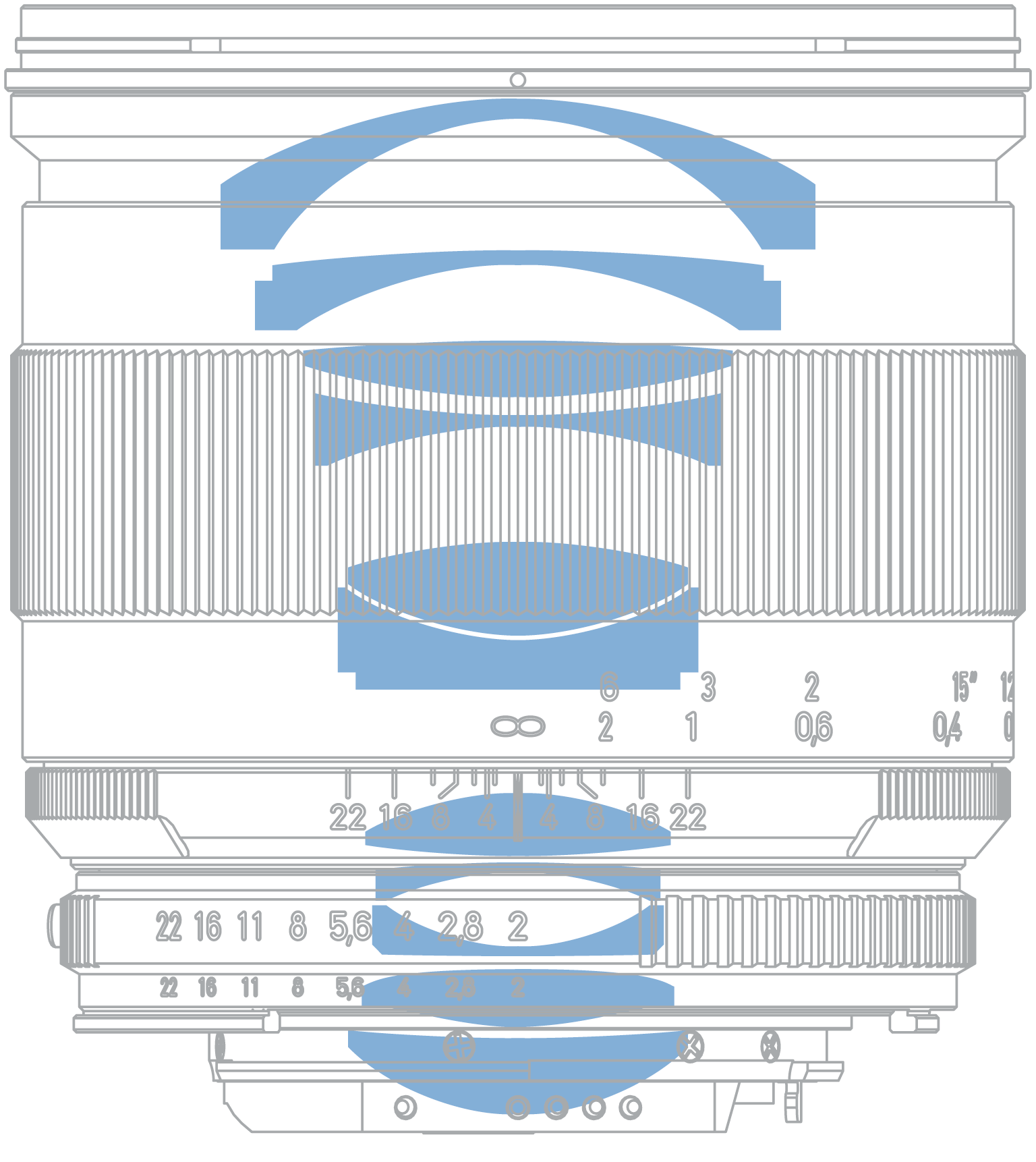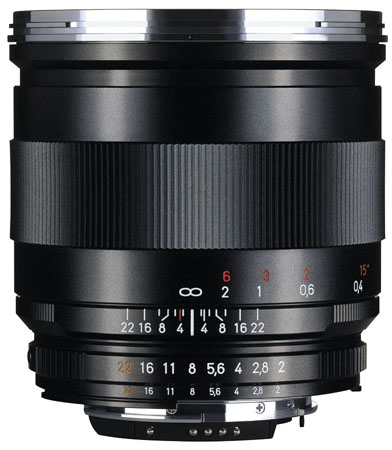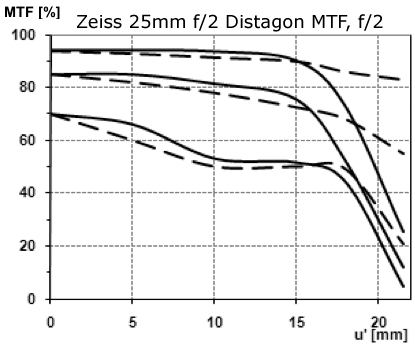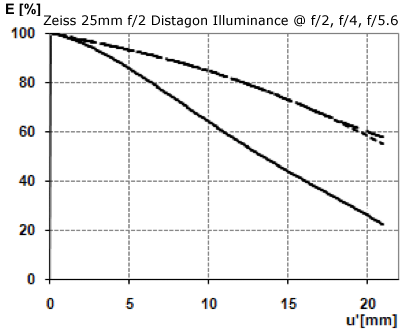Zeiss 25mm f/2 Distagon Announced

Extensive coverage of the new Zeiss 25mm f/2 Distagon will appear in my Zeiss Guide. Zeiss has promised me an evaluation ZE 25/2 lens (for Canon) due to arrive this Friday.
This is the first 25mm lens Zeiss has offered in Canon EF mount; the 25/2.8 Distagon has never been offered for Canon, only for Nikon, though the Nikon 25/2.8 Distagon can be used on Canon with a lens adapter.
Lens design
With special types of glass and two aspheric elements, Zeiss has apparently gone the extra mile to design an outstanding 25mm lens.
The MTF chart suggests that the new 25/2 can be expected to be a very high performing 25mm lens, with exceptionally high contrast across the frame that looks nearly as good as rangefinder lenses, quite an accomplishment, dropping off only in the extreme corners. It should be a stunning performer from what I can tell.
The 25/2 Distagon is a more compact lens than the 21/2.8 Distagon. Also, 67mm filters are much less expensive than 82mm, and match up with the 50/2 Makro-Planar and 100/2 Makro-Planar. Yet 21mm offers quite a bit wider angle of view, so owning both focal lengths is not unreasonable. Still, as an all-around lens, I’d suggest that 25mm will suit most users better than the ultra-wide 21mm, and the f/2 aperture adds some more flexibility as well.
When buying Zeiss (or other stuff), THANK YOU for using my links to B&H Photo.
| Focal length | 25 mm |
| Aperture range | f/2- f/22 |
| Number of lens elements/groups | 11 elements, 1 group |
| Focusing range: | 0.25 m - infinity |
| Angular field (diag./horiz./vert.) | 81/ 71/ 51 degrees |
| Coverage at close range | 219 x 144 mm |
| Image ratio at close range | 1 : 5.9 |
| Filter thread | M67 x 0.75 |
| Length with caps | 95 mm (ZF.2) 98 mm (ZE) |
| Diameter | 71 mm (ZF.2) 73 mm (ZE) |
| Weight (nominal) | 570 g (ZF.2) 600 g (ZE |
| Mounts | ZF.2 (F bayonet) ZE (EF bayonet) |


MTF
Zeiss commentary:
At full aperture, the new Distagon shows a very high contrast (10 and 20 lp/mm) across the complete APS-C image field (image height: 15mm). Only along the short sides and the corners of the full-frame image the performance continuously drops down. The contrast of very small details (40lp/mm) is also on a relatively high level within the APS-C field.
Stopped down moderately to f/4, the contrast of very small details (40lp/mm) significantly increases, whereas the small increase of 10 and 20lp/mm does not really effect in visible differences compared to the results at full aperture. The high performance now stays nearly identical up to an image height of 18mm, so only the outer corners of a full-frame image will still suffer from decreasing contrast.
Over all, the new 2/25 performs on a very high level. Like with all wide-angle lenses for DSLR cameras, only the outer corners of a full frame image will show a decrease in performance. Stopped down to f/5.6, this lens will show constant high performance at all image heights.
Compared to the 2,8/25, it is much of a better performer especially at closer distances, especially because of the much better correction of the field curvature.
While the 25/2 is already a strong performer at f/2, showing very high contrast for coarse and medium structures, stopping down to f/4 pops up the contrast in fine structures (40 lp/mm) very nicely. See Making Sharp Images for how to interpret MTF charts. As usual, it’s a pity that f/2.8 and f/5.6 graphs are not supplied for further insight.


Vignetting (illuminance)
It appears that all optical vignetting is gone by f/4, leaving only the unavoidable natural vignetting. This is an excellent performance for a 25mm prime lens.

Distortion
Distortion of 2% is clearly visible on horizons and straight edges, etc, but Zeiss and Leica consider 2% distortion as “nearly invisible”. Not to my eyes. Still, it’s quite acceptable, being barrel distortion as the edges are approached then reversing to very slight pincushion— wave distortion as is common with wide angle designs.

Zeiss press release
OBERKOCHEN, GERMANY, 27 October 2011
Exciting Perspectives in Low Light
Carl Zeiss presents the Distagon T* 2/25 ZE and ZF.2
Carl Zeiss presents the Distagon T* 2/25 ZE and ZF.2 moderate wide-angle lenses. The large image angle allows photographers to capture exciting perspectives.
With its excellent imaging quality at all aperture settings, the lens flexes its muscles particularly for photo documentaries in interior rooms where space is at a premium, as well as for pictures of objects, architecture and landscapes. In many situations, a flash is an unwelcome feature - at family gatherings, in a museum or in a church for example. To capture the mood in such places, photographers gladly do without aggressive lighting and instead work with particularly high-speed lenses that enable short exposure times even under difficult lighting conditions.
The optical experts have now virtually eliminated the chromatic aberrations on these lenses through a special design and selection of materials. Selected types of glass and two aspheric surfaces prevent color fringes from appearing on high-contrast edges.
"The Distagon T* 2/25 elegantly combines a compact design with a large initial aperture," explains Christian Bannert, Senior Director of Product Development in the Camera Lens Division at Carl Zeiss AG.\
Lens elements meticulously crafted to minimize stray light and reflections in the lens, and the Carl Zeiss T* anti-reflective coating to increase light transmission enable high-contrast image rendition and color saturation.
The previously available Distagon T* 2,8/25 ZF.2 will continue to be on stock and supplements the new Distagon T* 2/25.
Therefore, this new lens is also the first 25-mm lens of Carl Zeiss for the EF bayonet The Distagon T* 2/25 will be available end of 2011 at a recommended retail price of €1217 (excluding VAT)*.
...
Sales argument
Carl Zeiss optic experts have virtually eliminated the chromatic aberrations on these lenses through a special design and selection of materials. Selected types of glass and two aspheric surfaces prevent color fringes from appearing on high-contrast edges.
Target Group and typical applications
With its excellent imaging quality at all aperture settings, the Distagon T* 2/25 shows its benefits particularly for photo documentaries in interior rooms where space is at a premium and when low light requires a faster aperture. Also, it is a versatile focal length with a clear wide-angle effect, but without the artistic design difficulties of extremely short focal lengths. In addition to this, the Distagon T* 2/25 is the perfect fit for location photography with dynamic perspectives as well as landscape shots with emphasis on the foreground. For filmmakers using Zeiss DSLR lenses for HD video capture, the Distagon T*2/25 is a welcome addition to the 2/28, 2/35, 1,4/50 and 1,4/85 lenses.
Product Performance
The Distagon T* 2/25 was designed using two aspherical lens surfaces and four lens elements with special glasses and anomalous partial dispersion. Due to this, the Distagon T* 2/25 shows an outstanding correction of colors. The floating elements design ensures a high image quality up to close range. With its moderate overall size and its high aperture, this lens offers a great trade-off.
Floating element
The modern floating elements design compensates aberrations of the Distagon T* 2/25 at different distance settings. This is accomplished by changing the axial distance of single lens elements or element groups to each other. The adjustment of the element distance is coupled to the distance setting so that it always results in the right correction. The mechanical design of these lens elements is very complex and the workmanship must be particularly exact – both specialties of Carl Zeiss.
Competitor Comparison
The outstanding correction of color aberration of the Distagon T* 2/25 is extraordinary and provides images with particularly sharp contrasts without color fringes, even in areas of intensive light/shade intersections. The high starting aperture allows photographs to be taken without a tripod, even in difficult lighting conditions. It is almost distortion-free, making it ideal for use in architectural or location photography. Compared to other wide- angle lenses in this range with apertures of f/1.4, the Distagon T* 2/25 is smaller, lighter and delivers superior image quality.






























